Business Finance (BMS512): Investment Appraisal Report for S PLC
VerifiedAdded on 2023/06/18
|13
|3809
|354
Report
AI Summary
This business report provides a comprehensive financial analysis of S PLC, focusing on a new line of computer games and its associated investment proposal. The report includes a capital investment appraisal process, cash flow analysis, payback period calculation, net present value (NPV) assessment, internal rate of return (IRR) calculation, and a comparison of NPV and IRR methods. It critically contrasts bank loans and equity issues as long-term finance sources for S PLC. Furthermore, the report calculates break-even sales revenue, analyzes the consequences of price changes, and performs cost-volume-profit analysis. Finally, it distinguishes between different types of suppliers and compares single and multiple sourcing strategies, also explaining cross-sourcing and its benefits. The case study provides a detailed evaluation of the new investment and its financial implications for S PLC.

Business Report
Paraphrase This Document
Need a fresh take? Get an instant paraphrase of this document with our AI Paraphraser
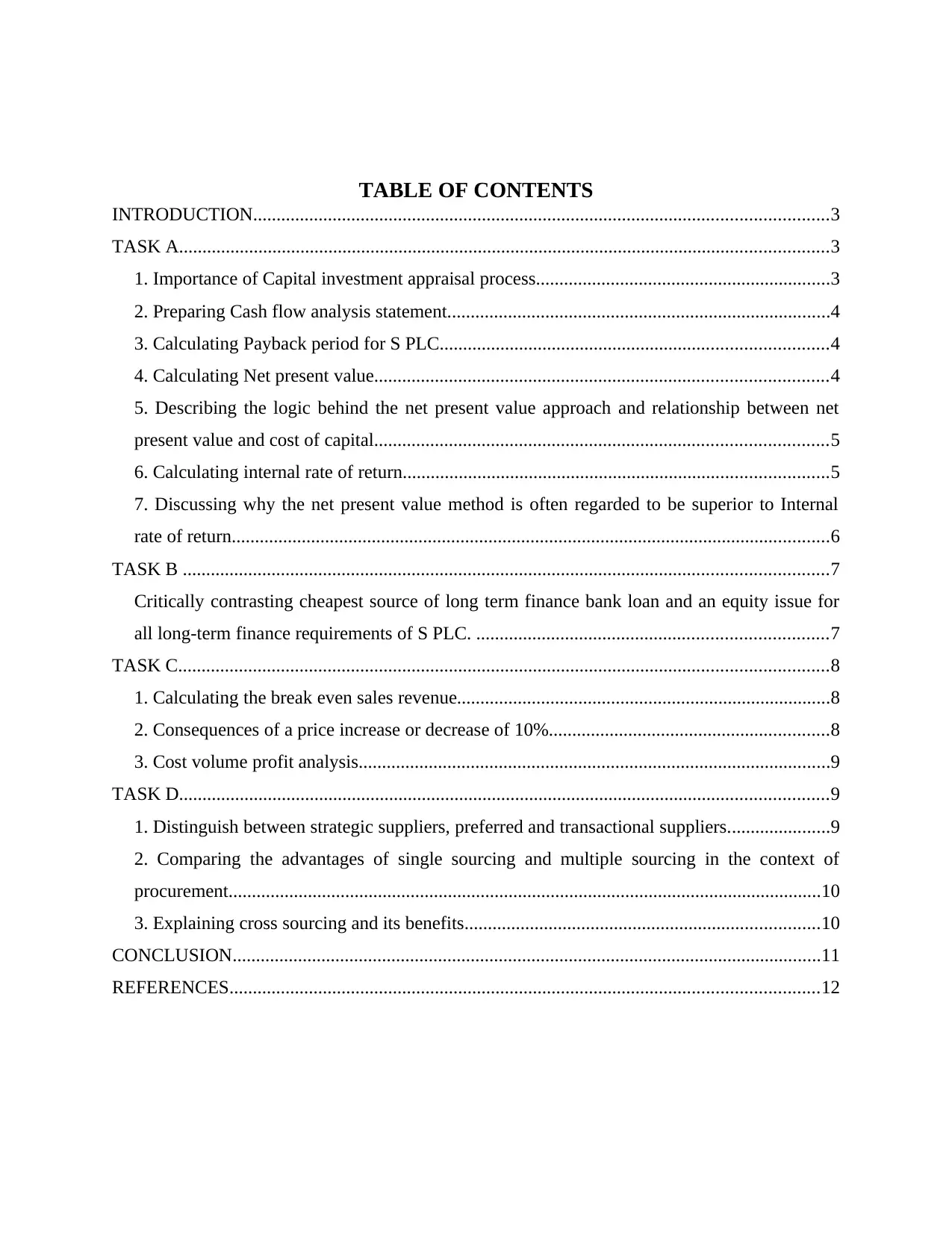
TABLE OF CONTENTS
INTRODUCTION...........................................................................................................................3
TASK A...........................................................................................................................................3
1. Importance of Capital investment appraisal process...............................................................3
2. Preparing Cash flow analysis statement..................................................................................4
3. Calculating Payback period for S PLC...................................................................................4
4. Calculating Net present value.................................................................................................4
5. Describing the logic behind the net present value approach and relationship between net
present value and cost of capital.................................................................................................5
6. Calculating internal rate of return...........................................................................................5
7. Discussing why the net present value method is often regarded to be superior to Internal
rate of return................................................................................................................................6
TASK B ..........................................................................................................................................7
Critically contrasting cheapest source of long term finance bank loan and an equity issue for
all long-term finance requirements of S PLC. ...........................................................................7
TASK C...........................................................................................................................................8
1. Calculating the break even sales revenue................................................................................8
2. Consequences of a price increase or decrease of 10%............................................................8
3. Cost volume profit analysis.....................................................................................................9
TASK D...........................................................................................................................................9
1. Distinguish between strategic suppliers, preferred and transactional suppliers......................9
2. Comparing the advantages of single sourcing and multiple sourcing in the context of
procurement...............................................................................................................................10
3. Explaining cross sourcing and its benefits............................................................................10
CONCLUSION..............................................................................................................................11
REFERENCES..............................................................................................................................12
INTRODUCTION...........................................................................................................................3
TASK A...........................................................................................................................................3
1. Importance of Capital investment appraisal process...............................................................3
2. Preparing Cash flow analysis statement..................................................................................4
3. Calculating Payback period for S PLC...................................................................................4
4. Calculating Net present value.................................................................................................4
5. Describing the logic behind the net present value approach and relationship between net
present value and cost of capital.................................................................................................5
6. Calculating internal rate of return...........................................................................................5
7. Discussing why the net present value method is often regarded to be superior to Internal
rate of return................................................................................................................................6
TASK B ..........................................................................................................................................7
Critically contrasting cheapest source of long term finance bank loan and an equity issue for
all long-term finance requirements of S PLC. ...........................................................................7
TASK C...........................................................................................................................................8
1. Calculating the break even sales revenue................................................................................8
2. Consequences of a price increase or decrease of 10%............................................................8
3. Cost volume profit analysis.....................................................................................................9
TASK D...........................................................................................................................................9
1. Distinguish between strategic suppliers, preferred and transactional suppliers......................9
2. Comparing the advantages of single sourcing and multiple sourcing in the context of
procurement...............................................................................................................................10
3. Explaining cross sourcing and its benefits............................................................................10
CONCLUSION..............................................................................................................................11
REFERENCES..............................................................................................................................12

INTRODUCTION
Business report is an official statement that provides overall information about company's
position and financial data. The report provides brief details about company's operations and
helps in taking decisions related to business. The case study will analyse a financial strategy
including financial, accounting and budgeting management of S PLC. Further, it evaluates
procurement and sourcing within the organization. Along with that, the report will calculate the
rate of return and break even sales revenue on the basis of given data. Additionally, it will
provide detailed explanation of long term finance requirement such as equity and bank loans and
cash flow statement. At last, the study will discuss single, cross and multiple sourcing and
various types of suppliers.
TASK A
1. Importance of Capital investment appraisal process
Investment appraisal helps the S PLC in various ways such as it gives information to
traders about stock or a company's long term potential based on the capabilities and
profitability.
It gives information about company resources and potential efforts used by S PLC in
order to achieve objectives. It is helpful in investment decision and strategic business
decisions to achieve desired long term goals.
In the company, understanding the risk totally depends upon cash flow analysis statement
(Warren and Seal, 2018). Thus, a capital investment appraisal includes the projected cash
flow and annual profit margins. From this the company can evaluate the performance and
profitability of long term achievement.
In order to review available investment, the company needs to compare between
alternative and proposed projects (Pawlak, Rapacewicz and Zarzecki, 2020). The
company needs to determine the available capital resources and then make investment
decision.
Capital investment appraisal process is important for S PLC because it is helpful to move
the project from initial investment to its inauguration in order to achieve goals.
Business report is an official statement that provides overall information about company's
position and financial data. The report provides brief details about company's operations and
helps in taking decisions related to business. The case study will analyse a financial strategy
including financial, accounting and budgeting management of S PLC. Further, it evaluates
procurement and sourcing within the organization. Along with that, the report will calculate the
rate of return and break even sales revenue on the basis of given data. Additionally, it will
provide detailed explanation of long term finance requirement such as equity and bank loans and
cash flow statement. At last, the study will discuss single, cross and multiple sourcing and
various types of suppliers.
TASK A
1. Importance of Capital investment appraisal process
Investment appraisal helps the S PLC in various ways such as it gives information to
traders about stock or a company's long term potential based on the capabilities and
profitability.
It gives information about company resources and potential efforts used by S PLC in
order to achieve objectives. It is helpful in investment decision and strategic business
decisions to achieve desired long term goals.
In the company, understanding the risk totally depends upon cash flow analysis statement
(Warren and Seal, 2018). Thus, a capital investment appraisal includes the projected cash
flow and annual profit margins. From this the company can evaluate the performance and
profitability of long term achievement.
In order to review available investment, the company needs to compare between
alternative and proposed projects (Pawlak, Rapacewicz and Zarzecki, 2020). The
company needs to determine the available capital resources and then make investment
decision.
Capital investment appraisal process is important for S PLC because it is helpful to move
the project from initial investment to its inauguration in order to achieve goals.
⊘ This is a preview!⊘
Do you want full access?
Subscribe today to unlock all pages.

Trusted by 1+ million students worldwide

2. Preparing Cash flow analysis statement.
Particulars / Year
1
(in £)
2
(in £)
3
(in £)
4
(in £)
5
(in £)
Sales revenue 600 1000 1200 1000 800
Less: Cost of sales 180 300 360 300 240
Incremental cost 100 100 100 100 100
Depreciation 200 200 200 200 200
Total expenses 480 600 660 600 540
EAT 120 400 540 400 260
Add: Depreciation 200 200 200 200 200
Net cash inflow 320 600 740 600 460
3. Calculating Payback period for S PLC
The amount of time period takes to recover that cost of an investment is called payback
period. The short payback period is more beneficial for company in order to achieve business
goals. The payback period calculations can be done by anyone and helpful in taking decision
about investments.
Year Cash inflows (in £)
Cumulative cash
inflows (in £)
1 320 320
2 600 920
3 740 1660
4 600 2260
5 460 2720
Payback period
2 + (1300- 920) / 740 =
2.5 years
From this the company can find out the net cash flows by dividing the initial investment.
From the above mentioned calculation it is evaluated that the payback period is 2.5 years which
is good for the company's performance. Yes, the project can be accepted by S PLC if the
company imposes a three-year maximum payback period.
Particulars / Year
1
(in £)
2
(in £)
3
(in £)
4
(in £)
5
(in £)
Sales revenue 600 1000 1200 1000 800
Less: Cost of sales 180 300 360 300 240
Incremental cost 100 100 100 100 100
Depreciation 200 200 200 200 200
Total expenses 480 600 660 600 540
EAT 120 400 540 400 260
Add: Depreciation 200 200 200 200 200
Net cash inflow 320 600 740 600 460
3. Calculating Payback period for S PLC
The amount of time period takes to recover that cost of an investment is called payback
period. The short payback period is more beneficial for company in order to achieve business
goals. The payback period calculations can be done by anyone and helpful in taking decision
about investments.
Year Cash inflows (in £)
Cumulative cash
inflows (in £)
1 320 320
2 600 920
3 740 1660
4 600 2260
5 460 2720
Payback period
2 + (1300- 920) / 740 =
2.5 years
From this the company can find out the net cash flows by dividing the initial investment.
From the above mentioned calculation it is evaluated that the payback period is 2.5 years which
is good for the company's performance. Yes, the project can be accepted by S PLC if the
company imposes a three-year maximum payback period.
Paraphrase This Document
Need a fresh take? Get an instant paraphrase of this document with our AI Paraphraser

4. Calculating Net present value
From the above mentioned table it is evaluated that the investment proposal will be
accepted by S PLC Because, Net present value is positive. The discounted present value of S
PLC is positive just because of positive NPV. Thus, the positive NPV indicates that it will be
profitable for company and beneficial for successful business. It is used to calculate the total
value of future stream of payment and also estimate cash flow for each time period.
Year Cash inflows (in £) PV factor @20%
Discounted cash
inflows (in £)
1 320 0.833 267
2 600 0.694 417
3 740 0.579 428
4 600 0.482 289
5 460 0.402 185
Total discounted cash
inflows 1586
Less: initial
investment 1300
NPV 286
It is said that if the net present value of investment or any project is negative, it
means that discounted present value of cash flows will be negative, therefore that investment will
not be accepted.
5. Describing the logic behind the net present value approach and relationship between net
present value and cost of capital.
Net present value refers to the difference between the flows of the cash by taking the
present values of both the flows. It is a method used in capital budgeting. It is used to analyse the
profits of the projects of the company. The positive NPV shows that it exceeds the planned costs.
When the NPV is positive it it is assumed that it is always profitable for the company. It shows
the worth of the project and flows of the cash of the company.
The formula of net present value and the cost of capital is important because it makes the
comparison in dollars in decision-making of the company (Drobetz, W. and et.al., 2018). The
From the above mentioned table it is evaluated that the investment proposal will be
accepted by S PLC Because, Net present value is positive. The discounted present value of S
PLC is positive just because of positive NPV. Thus, the positive NPV indicates that it will be
profitable for company and beneficial for successful business. It is used to calculate the total
value of future stream of payment and also estimate cash flow for each time period.
Year Cash inflows (in £) PV factor @20%
Discounted cash
inflows (in £)
1 320 0.833 267
2 600 0.694 417
3 740 0.579 428
4 600 0.482 289
5 460 0.402 185
Total discounted cash
inflows 1586
Less: initial
investment 1300
NPV 286
It is said that if the net present value of investment or any project is negative, it
means that discounted present value of cash flows will be negative, therefore that investment will
not be accepted.
5. Describing the logic behind the net present value approach and relationship between net
present value and cost of capital.
Net present value refers to the difference between the flows of the cash by taking the
present values of both the flows. It is a method used in capital budgeting. It is used to analyse the
profits of the projects of the company. The positive NPV shows that it exceeds the planned costs.
When the NPV is positive it it is assumed that it is always profitable for the company. It shows
the worth of the project and flows of the cash of the company.
The formula of net present value and the cost of capital is important because it makes the
comparison in dollars in decision-making of the company (Drobetz, W. and et.al., 2018). The
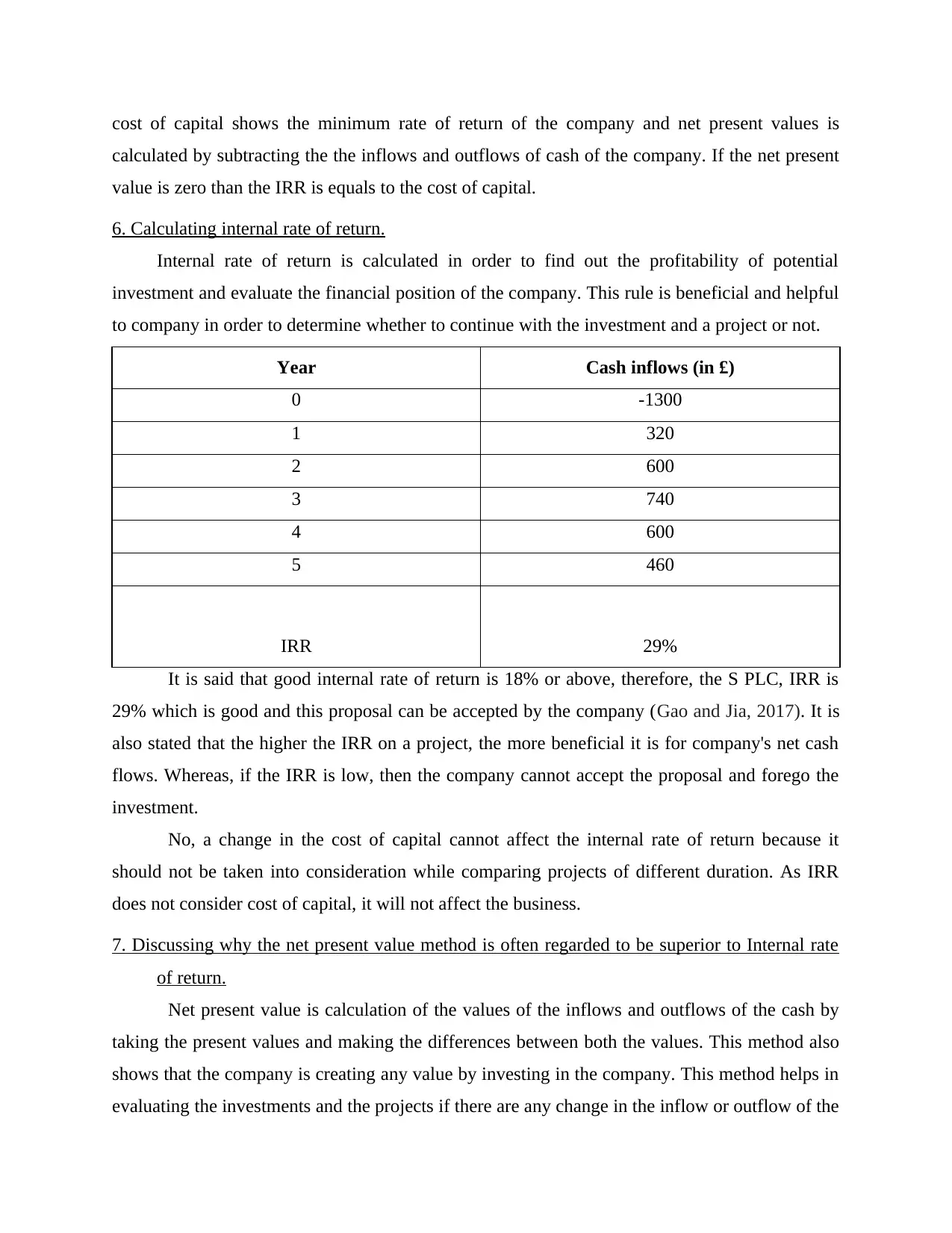
cost of capital shows the minimum rate of return of the company and net present values is
calculated by subtracting the the inflows and outflows of cash of the company. If the net present
value is zero than the IRR is equals to the cost of capital.
6. Calculating internal rate of return.
Internal rate of return is calculated in order to find out the profitability of potential
investment and evaluate the financial position of the company. This rule is beneficial and helpful
to company in order to determine whether to continue with the investment and a project or not.
Year Cash inflows (in £)
0 -1300
1 320
2 600
3 740
4 600
5 460
IRR 29%
It is said that good internal rate of return is 18% or above, therefore, the S PLC, IRR is
29% which is good and this proposal can be accepted by the company (Gao and Jia, 2017). It is
also stated that the higher the IRR on a project, the more beneficial it is for company's net cash
flows. Whereas, if the IRR is low, then the company cannot accept the proposal and forego the
investment.
No, a change in the cost of capital cannot affect the internal rate of return because it
should not be taken into consideration while comparing projects of different duration. As IRR
does not consider cost of capital, it will not affect the business.
7. Discussing why the net present value method is often regarded to be superior to Internal rate
of return.
Net present value is calculation of the values of the inflows and outflows of the cash by
taking the present values and making the differences between both the values. This method also
shows that the company is creating any value by investing in the company. This method helps in
evaluating the investments and the projects if there are any change in the inflow or outflow of the
calculated by subtracting the the inflows and outflows of cash of the company. If the net present
value is zero than the IRR is equals to the cost of capital.
6. Calculating internal rate of return.
Internal rate of return is calculated in order to find out the profitability of potential
investment and evaluate the financial position of the company. This rule is beneficial and helpful
to company in order to determine whether to continue with the investment and a project or not.
Year Cash inflows (in £)
0 -1300
1 320
2 600
3 740
4 600
5 460
IRR 29%
It is said that good internal rate of return is 18% or above, therefore, the S PLC, IRR is
29% which is good and this proposal can be accepted by the company (Gao and Jia, 2017). It is
also stated that the higher the IRR on a project, the more beneficial it is for company's net cash
flows. Whereas, if the IRR is low, then the company cannot accept the proposal and forego the
investment.
No, a change in the cost of capital cannot affect the internal rate of return because it
should not be taken into consideration while comparing projects of different duration. As IRR
does not consider cost of capital, it will not affect the business.
7. Discussing why the net present value method is often regarded to be superior to Internal rate
of return.
Net present value is calculation of the values of the inflows and outflows of the cash by
taking the present values and making the differences between both the values. This method also
shows that the company is creating any value by investing in the company. This method helps in
evaluating the investments and the projects if there are any change in the inflow or outflow of the
⊘ This is a preview!⊘
Do you want full access?
Subscribe today to unlock all pages.

Trusted by 1+ million students worldwide

cash (Maravas and Pantouvakis, 2018). The main reason is that this method is easily
understandable by public. This method helps to increase the profit of the company. Time value
of money is important in this method because it shows the value of money higher as compare to
money will be received in the coming years. This method is superior because it works on the life
of the project by checking the inflows and outflows of the cash of the project.
TASK B
Critically contrasting cheapest source of long term finance bank loan and an equity issue for all
long-term finance requirements of S PLC.
Bank loans are debt financing in which the company borrow money and must pay it back
to bank with interest within given time period (Lefley, 2018). In equity, company raise money by
selling a portion of ownership in order to achieve targets. Selling new ownership interests can
help to develop equity financing requirements.
Both borrowing and equity fall under the long term financing sources. In equity, more
money can be transmitted into growing business and gain profit (Rachman and et.al., 2018). S
plc will raise several rounds of equity from various types of investors over the course of the
business life cycle. By receiving dividends, equity investors make a return on investment, thus
right investor gives expertise and help the company in growing business.
Whereas, due to low risk debt finance (secured) such as bank loan is generally easier to
obtain and cheapest source of long term finance. Bank loans can be repaid over a set period,
generally in monthly instalments (Naich and et.al., 2020). The bank may ask the borrower to
pledge an asset as security for the bank loan, such as property or any equipment. If the borrower
can’t repay, then the bank may claim the asset to get their money back. Equity investor may ask
to have an input into the overall direction and can be involved in company decision-making
process in order to business growth. Whereas, a bank has no ownership and therefore no
involvement in the business strategic decisions.
Ultimately, the long term financing method S PLC choose, it will totally depend on
business situation including performance of the company, company's growth, financial position,
its stages of development and nature of business.
understandable by public. This method helps to increase the profit of the company. Time value
of money is important in this method because it shows the value of money higher as compare to
money will be received in the coming years. This method is superior because it works on the life
of the project by checking the inflows and outflows of the cash of the project.
TASK B
Critically contrasting cheapest source of long term finance bank loan and an equity issue for all
long-term finance requirements of S PLC.
Bank loans are debt financing in which the company borrow money and must pay it back
to bank with interest within given time period (Lefley, 2018). In equity, company raise money by
selling a portion of ownership in order to achieve targets. Selling new ownership interests can
help to develop equity financing requirements.
Both borrowing and equity fall under the long term financing sources. In equity, more
money can be transmitted into growing business and gain profit (Rachman and et.al., 2018). S
plc will raise several rounds of equity from various types of investors over the course of the
business life cycle. By receiving dividends, equity investors make a return on investment, thus
right investor gives expertise and help the company in growing business.
Whereas, due to low risk debt finance (secured) such as bank loan is generally easier to
obtain and cheapest source of long term finance. Bank loans can be repaid over a set period,
generally in monthly instalments (Naich and et.al., 2020). The bank may ask the borrower to
pledge an asset as security for the bank loan, such as property or any equipment. If the borrower
can’t repay, then the bank may claim the asset to get their money back. Equity investor may ask
to have an input into the overall direction and can be involved in company decision-making
process in order to business growth. Whereas, a bank has no ownership and therefore no
involvement in the business strategic decisions.
Ultimately, the long term financing method S PLC choose, it will totally depend on
business situation including performance of the company, company's growth, financial position,
its stages of development and nature of business.
Paraphrase This Document
Need a fresh take? Get an instant paraphrase of this document with our AI Paraphraser
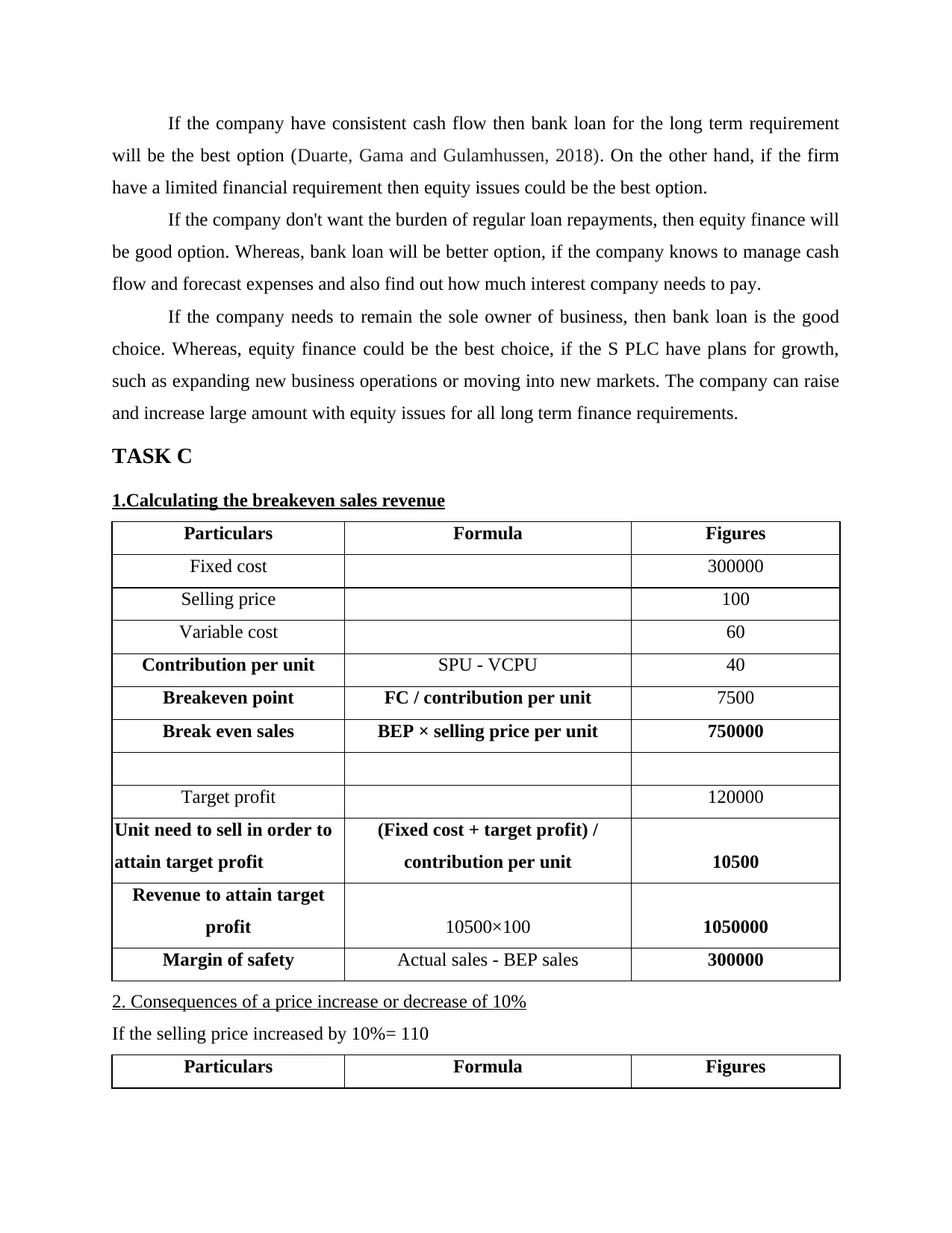
If the company have consistent cash flow then bank loan for the long term requirement
will be the best option (Duarte, Gama and Gulamhussen, 2018). On the other hand, if the firm
have a limited financial requirement then equity issues could be the best option.
If the company don't want the burden of regular loan repayments, then equity finance will
be good option. Whereas, bank loan will be better option, if the company knows to manage cash
flow and forecast expenses and also find out how much interest company needs to pay.
If the company needs to remain the sole owner of business, then bank loan is the good
choice. Whereas, equity finance could be the best choice, if the S PLC have plans for growth,
such as expanding new business operations or moving into new markets. The company can raise
and increase large amount with equity issues for all long term finance requirements.
TASK C
1.Calculating the breakeven sales revenue
Particulars Formula Figures
Fixed cost 300000
Selling price 100
Variable cost 60
Contribution per unit SPU - VCPU 40
Breakeven point FC / contribution per unit 7500
Break even sales BEP × selling price per unit 750000
Target profit 120000
Unit need to sell in order to
attain target profit
(Fixed cost + target profit) /
contribution per unit 10500
Revenue to attain target
profit 10500×100 1050000
Margin of safety Actual sales - BEP sales 300000
2. Consequences of a price increase or decrease of 10%
If the selling price increased by 10%= 110
Particulars Formula Figures
will be the best option (Duarte, Gama and Gulamhussen, 2018). On the other hand, if the firm
have a limited financial requirement then equity issues could be the best option.
If the company don't want the burden of regular loan repayments, then equity finance will
be good option. Whereas, bank loan will be better option, if the company knows to manage cash
flow and forecast expenses and also find out how much interest company needs to pay.
If the company needs to remain the sole owner of business, then bank loan is the good
choice. Whereas, equity finance could be the best choice, if the S PLC have plans for growth,
such as expanding new business operations or moving into new markets. The company can raise
and increase large amount with equity issues for all long term finance requirements.
TASK C
1.Calculating the breakeven sales revenue
Particulars Formula Figures
Fixed cost 300000
Selling price 100
Variable cost 60
Contribution per unit SPU - VCPU 40
Breakeven point FC / contribution per unit 7500
Break even sales BEP × selling price per unit 750000
Target profit 120000
Unit need to sell in order to
attain target profit
(Fixed cost + target profit) /
contribution per unit 10500
Revenue to attain target
profit 10500×100 1050000
Margin of safety Actual sales - BEP sales 300000
2. Consequences of a price increase or decrease of 10%
If the selling price increased by 10%= 110
Particulars Formula Figures
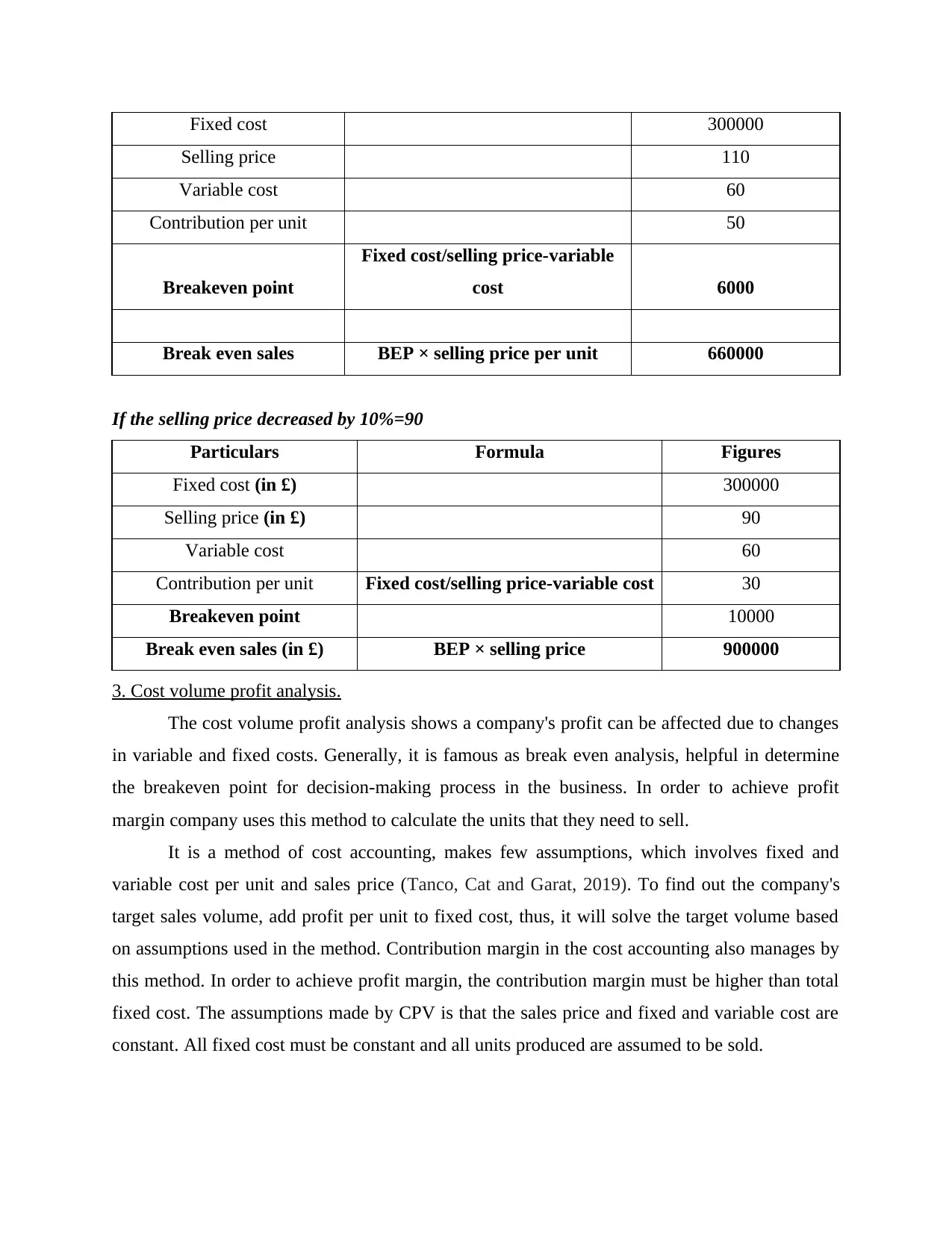
Fixed cost 300000
Selling price 110
Variable cost 60
Contribution per unit 50
Breakeven point
Fixed cost/selling price-variable
cost 6000
Break even sales BEP × selling price per unit 660000
If the selling price decreased by 10%=90
Particulars Formula Figures
Fixed cost (in £) 300000
Selling price (in £) 90
Variable cost 60
Contribution per unit Fixed cost/selling price-variable cost 30
Breakeven point 10000
Break even sales (in £) BEP × selling price 900000
3. Cost volume profit analysis.
The cost volume profit analysis shows a company's profit can be affected due to changes
in variable and fixed costs. Generally, it is famous as break even analysis, helpful in determine
the breakeven point for decision-making process in the business. In order to achieve profit
margin company uses this method to calculate the units that they need to sell.
It is a method of cost accounting, makes few assumptions, which involves fixed and
variable cost per unit and sales price (Tanco, Cat and Garat, 2019). To find out the company's
target sales volume, add profit per unit to fixed cost, thus, it will solve the target volume based
on assumptions used in the method. Contribution margin in the cost accounting also manages by
this method. In order to achieve profit margin, the contribution margin must be higher than total
fixed cost. The assumptions made by CPV is that the sales price and fixed and variable cost are
constant. All fixed cost must be constant and all units produced are assumed to be sold.
Selling price 110
Variable cost 60
Contribution per unit 50
Breakeven point
Fixed cost/selling price-variable
cost 6000
Break even sales BEP × selling price per unit 660000
If the selling price decreased by 10%=90
Particulars Formula Figures
Fixed cost (in £) 300000
Selling price (in £) 90
Variable cost 60
Contribution per unit Fixed cost/selling price-variable cost 30
Breakeven point 10000
Break even sales (in £) BEP × selling price 900000
3. Cost volume profit analysis.
The cost volume profit analysis shows a company's profit can be affected due to changes
in variable and fixed costs. Generally, it is famous as break even analysis, helpful in determine
the breakeven point for decision-making process in the business. In order to achieve profit
margin company uses this method to calculate the units that they need to sell.
It is a method of cost accounting, makes few assumptions, which involves fixed and
variable cost per unit and sales price (Tanco, Cat and Garat, 2019). To find out the company's
target sales volume, add profit per unit to fixed cost, thus, it will solve the target volume based
on assumptions used in the method. Contribution margin in the cost accounting also manages by
this method. In order to achieve profit margin, the contribution margin must be higher than total
fixed cost. The assumptions made by CPV is that the sales price and fixed and variable cost are
constant. All fixed cost must be constant and all units produced are assumed to be sold.
⊘ This is a preview!⊘
Do you want full access?
Subscribe today to unlock all pages.

Trusted by 1+ million students worldwide
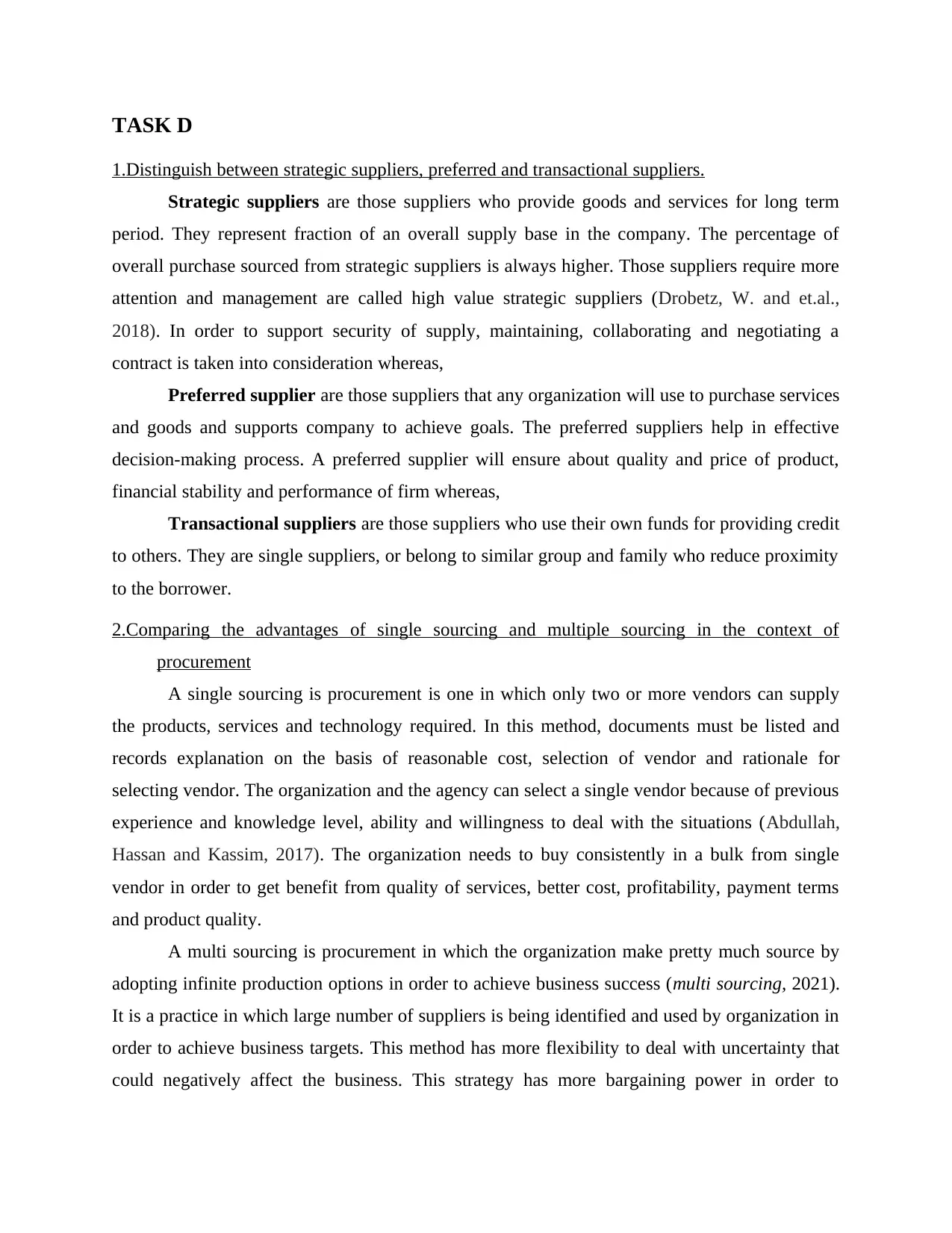
TASK D
1.Distinguish between strategic suppliers, preferred and transactional suppliers.
Strategic suppliers are those suppliers who provide goods and services for long term
period. They represent fraction of an overall supply base in the company. The percentage of
overall purchase sourced from strategic suppliers is always higher. Those suppliers require more
attention and management are called high value strategic suppliers (Drobetz, W. and et.al.,
2018). In order to support security of supply, maintaining, collaborating and negotiating a
contract is taken into consideration whereas,
Preferred supplier are those suppliers that any organization will use to purchase services
and goods and supports company to achieve goals. The preferred suppliers help in effective
decision-making process. A preferred supplier will ensure about quality and price of product,
financial stability and performance of firm whereas,
Transactional suppliers are those suppliers who use their own funds for providing credit
to others. They are single suppliers, or belong to similar group and family who reduce proximity
to the borrower.
2.Comparing the advantages of single sourcing and multiple sourcing in the context of
procurement
A single sourcing is procurement is one in which only two or more vendors can supply
the products, services and technology required. In this method, documents must be listed and
records explanation on the basis of reasonable cost, selection of vendor and rationale for
selecting vendor. The organization and the agency can select a single vendor because of previous
experience and knowledge level, ability and willingness to deal with the situations (Abdullah,
Hassan and Kassim, 2017). The organization needs to buy consistently in a bulk from single
vendor in order to get benefit from quality of services, better cost, profitability, payment terms
and product quality.
A multi sourcing is procurement in which the organization make pretty much source by
adopting infinite production options in order to achieve business success (multi sourcing, 2021).
It is a practice in which large number of suppliers is being identified and used by organization in
order to achieve business targets. This method has more flexibility to deal with uncertainty that
could negatively affect the business. This strategy has more bargaining power in order to
1.Distinguish between strategic suppliers, preferred and transactional suppliers.
Strategic suppliers are those suppliers who provide goods and services for long term
period. They represent fraction of an overall supply base in the company. The percentage of
overall purchase sourced from strategic suppliers is always higher. Those suppliers require more
attention and management are called high value strategic suppliers (Drobetz, W. and et.al.,
2018). In order to support security of supply, maintaining, collaborating and negotiating a
contract is taken into consideration whereas,
Preferred supplier are those suppliers that any organization will use to purchase services
and goods and supports company to achieve goals. The preferred suppliers help in effective
decision-making process. A preferred supplier will ensure about quality and price of product,
financial stability and performance of firm whereas,
Transactional suppliers are those suppliers who use their own funds for providing credit
to others. They are single suppliers, or belong to similar group and family who reduce proximity
to the borrower.
2.Comparing the advantages of single sourcing and multiple sourcing in the context of
procurement
A single sourcing is procurement is one in which only two or more vendors can supply
the products, services and technology required. In this method, documents must be listed and
records explanation on the basis of reasonable cost, selection of vendor and rationale for
selecting vendor. The organization and the agency can select a single vendor because of previous
experience and knowledge level, ability and willingness to deal with the situations (Abdullah,
Hassan and Kassim, 2017). The organization needs to buy consistently in a bulk from single
vendor in order to get benefit from quality of services, better cost, profitability, payment terms
and product quality.
A multi sourcing is procurement in which the organization make pretty much source by
adopting infinite production options in order to achieve business success (multi sourcing, 2021).
It is a practice in which large number of suppliers is being identified and used by organization in
order to achieve business targets. This method has more flexibility to deal with uncertainty that
could negatively affect the business. This strategy has more bargaining power in order to
Paraphrase This Document
Need a fresh take? Get an instant paraphrase of this document with our AI Paraphraser
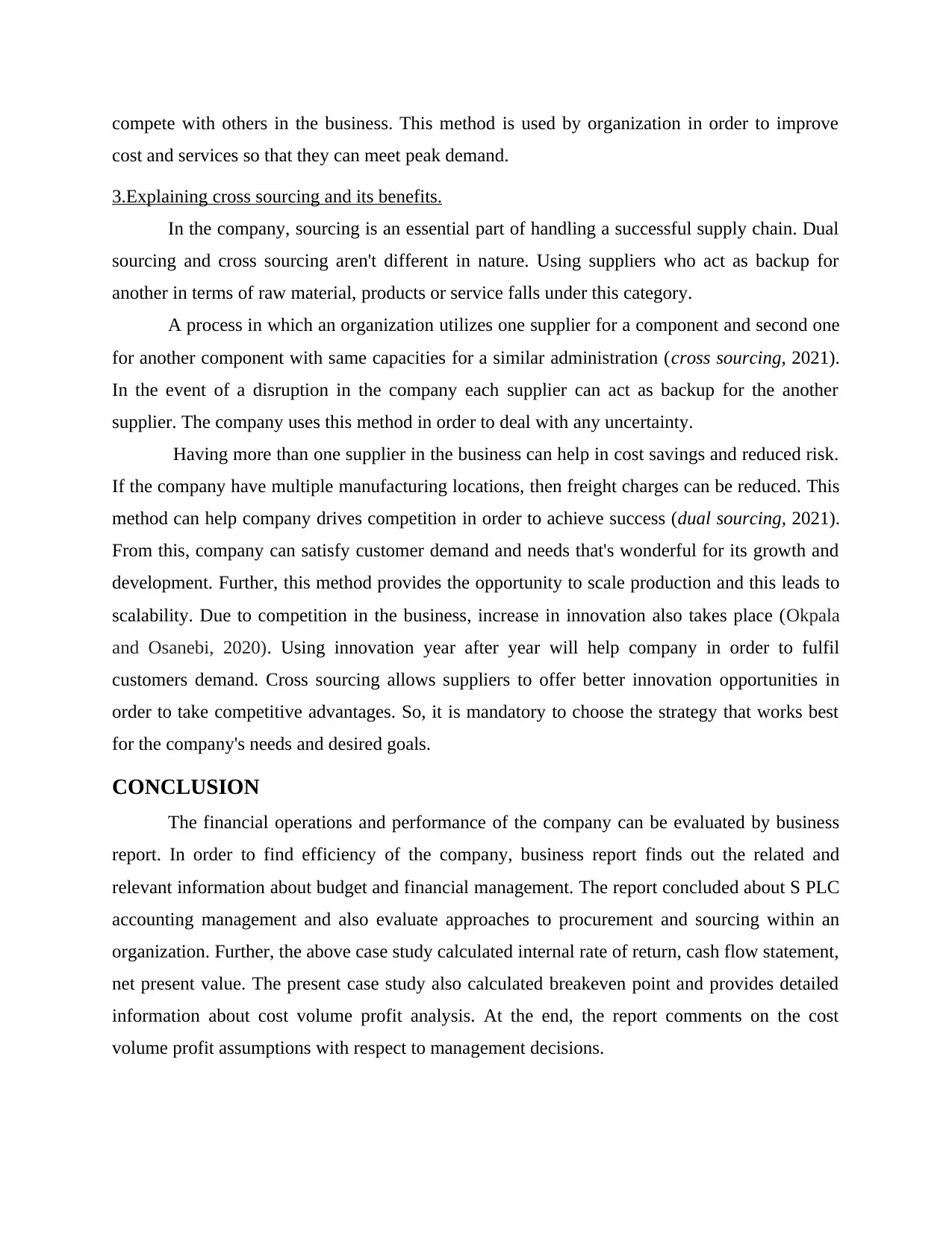
compete with others in the business. This method is used by organization in order to improve
cost and services so that they can meet peak demand.
3.Explaining cross sourcing and its benefits.
In the company, sourcing is an essential part of handling a successful supply chain. Dual
sourcing and cross sourcing aren't different in nature. Using suppliers who act as backup for
another in terms of raw material, products or service falls under this category.
A process in which an organization utilizes one supplier for a component and second one
for another component with same capacities for a similar administration (cross sourcing, 2021).
In the event of a disruption in the company each supplier can act as backup for the another
supplier. The company uses this method in order to deal with any uncertainty.
Having more than one supplier in the business can help in cost savings and reduced risk.
If the company have multiple manufacturing locations, then freight charges can be reduced. This
method can help company drives competition in order to achieve success (dual sourcing, 2021).
From this, company can satisfy customer demand and needs that's wonderful for its growth and
development. Further, this method provides the opportunity to scale production and this leads to
scalability. Due to competition in the business, increase in innovation also takes place (Okpala
and Osanebi, 2020). Using innovation year after year will help company in order to fulfil
customers demand. Cross sourcing allows suppliers to offer better innovation opportunities in
order to take competitive advantages. So, it is mandatory to choose the strategy that works best
for the company's needs and desired goals.
CONCLUSION
The financial operations and performance of the company can be evaluated by business
report. In order to find efficiency of the company, business report finds out the related and
relevant information about budget and financial management. The report concluded about S PLC
accounting management and also evaluate approaches to procurement and sourcing within an
organization. Further, the above case study calculated internal rate of return, cash flow statement,
net present value. The present case study also calculated breakeven point and provides detailed
information about cost volume profit analysis. At the end, the report comments on the cost
volume profit assumptions with respect to management decisions.
cost and services so that they can meet peak demand.
3.Explaining cross sourcing and its benefits.
In the company, sourcing is an essential part of handling a successful supply chain. Dual
sourcing and cross sourcing aren't different in nature. Using suppliers who act as backup for
another in terms of raw material, products or service falls under this category.
A process in which an organization utilizes one supplier for a component and second one
for another component with same capacities for a similar administration (cross sourcing, 2021).
In the event of a disruption in the company each supplier can act as backup for the another
supplier. The company uses this method in order to deal with any uncertainty.
Having more than one supplier in the business can help in cost savings and reduced risk.
If the company have multiple manufacturing locations, then freight charges can be reduced. This
method can help company drives competition in order to achieve success (dual sourcing, 2021).
From this, company can satisfy customer demand and needs that's wonderful for its growth and
development. Further, this method provides the opportunity to scale production and this leads to
scalability. Due to competition in the business, increase in innovation also takes place (Okpala
and Osanebi, 2020). Using innovation year after year will help company in order to fulfil
customers demand. Cross sourcing allows suppliers to offer better innovation opportunities in
order to take competitive advantages. So, it is mandatory to choose the strategy that works best
for the company's needs and desired goals.
CONCLUSION
The financial operations and performance of the company can be evaluated by business
report. In order to find efficiency of the company, business report finds out the related and
relevant information about budget and financial management. The report concluded about S PLC
accounting management and also evaluate approaches to procurement and sourcing within an
organization. Further, the above case study calculated internal rate of return, cash flow statement,
net present value. The present case study also calculated breakeven point and provides detailed
information about cost volume profit analysis. At the end, the report comments on the cost
volume profit assumptions with respect to management decisions.
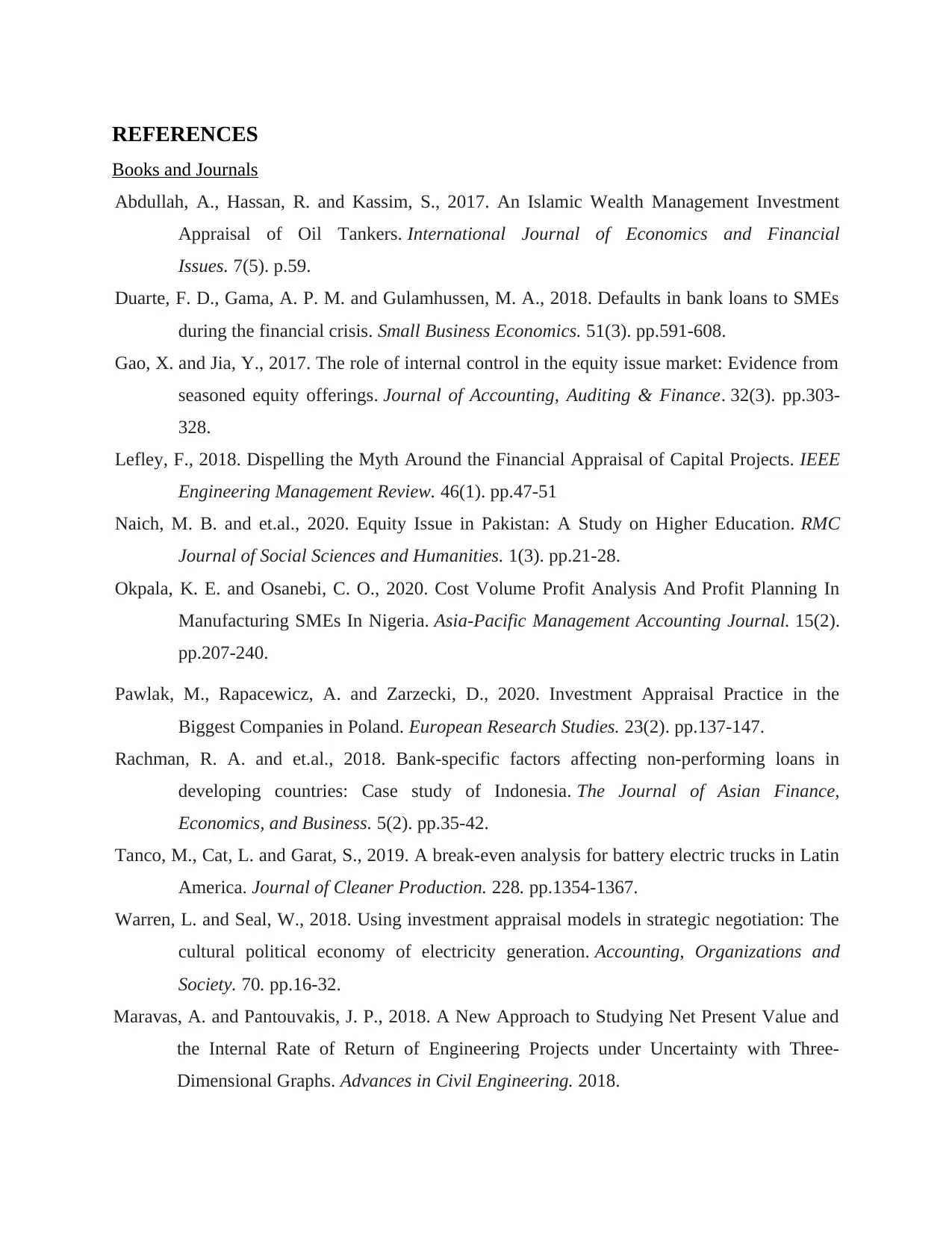
REFERENCES
Books and Journals
Abdullah, A., Hassan, R. and Kassim, S., 2017. An Islamic Wealth Management Investment
Appraisal of Oil Tankers. International Journal of Economics and Financial
Issues. 7(5). p.59.
Duarte, F. D., Gama, A. P. M. and Gulamhussen, M. A., 2018. Defaults in bank loans to SMEs
during the financial crisis. Small Business Economics. 51(3). pp.591-608.
Gao, X. and Jia, Y., 2017. The role of internal control in the equity issue market: Evidence from
seasoned equity offerings. Journal of Accounting, Auditing & Finance. 32(3). pp.303-
328.
Lefley, F., 2018. Dispelling the Myth Around the Financial Appraisal of Capital Projects. IEEE
Engineering Management Review. 46(1). pp.47-51
Naich, M. B. and et.al., 2020. Equity Issue in Pakistan: A Study on Higher Education. RMC
Journal of Social Sciences and Humanities. 1(3). pp.21-28.
Okpala, K. E. and Osanebi, C. O., 2020. Cost Volume Profit Analysis And Profit Planning In
Manufacturing SMEs In Nigeria. Asia-Pacific Management Accounting Journal. 15(2).
pp.207-240.
Pawlak, M., Rapacewicz, A. and Zarzecki, D., 2020. Investment Appraisal Practice in the
Biggest Companies in Poland. European Research Studies. 23(2). pp.137-147.
Rachman, R. A. and et.al., 2018. Bank-specific factors affecting non-performing loans in
developing countries: Case study of Indonesia. The Journal of Asian Finance,
Economics, and Business. 5(2). pp.35-42.
Tanco, M., Cat, L. and Garat, S., 2019. A break-even analysis for battery electric trucks in Latin
America. Journal of Cleaner Production. 228. pp.1354-1367.
Warren, L. and Seal, W., 2018. Using investment appraisal models in strategic negotiation: The
cultural political economy of electricity generation. Accounting, Organizations and
Society. 70. pp.16-32.
Maravas, A. and Pantouvakis, J. P., 2018. A New Approach to Studying Net Present Value and
the Internal Rate of Return of Engineering Projects under Uncertainty with Three-
Dimensional Graphs. Advances in Civil Engineering. 2018.
Books and Journals
Abdullah, A., Hassan, R. and Kassim, S., 2017. An Islamic Wealth Management Investment
Appraisal of Oil Tankers. International Journal of Economics and Financial
Issues. 7(5). p.59.
Duarte, F. D., Gama, A. P. M. and Gulamhussen, M. A., 2018. Defaults in bank loans to SMEs
during the financial crisis. Small Business Economics. 51(3). pp.591-608.
Gao, X. and Jia, Y., 2017. The role of internal control in the equity issue market: Evidence from
seasoned equity offerings. Journal of Accounting, Auditing & Finance. 32(3). pp.303-
328.
Lefley, F., 2018. Dispelling the Myth Around the Financial Appraisal of Capital Projects. IEEE
Engineering Management Review. 46(1). pp.47-51
Naich, M. B. and et.al., 2020. Equity Issue in Pakistan: A Study on Higher Education. RMC
Journal of Social Sciences and Humanities. 1(3). pp.21-28.
Okpala, K. E. and Osanebi, C. O., 2020. Cost Volume Profit Analysis And Profit Planning In
Manufacturing SMEs In Nigeria. Asia-Pacific Management Accounting Journal. 15(2).
pp.207-240.
Pawlak, M., Rapacewicz, A. and Zarzecki, D., 2020. Investment Appraisal Practice in the
Biggest Companies in Poland. European Research Studies. 23(2). pp.137-147.
Rachman, R. A. and et.al., 2018. Bank-specific factors affecting non-performing loans in
developing countries: Case study of Indonesia. The Journal of Asian Finance,
Economics, and Business. 5(2). pp.35-42.
Tanco, M., Cat, L. and Garat, S., 2019. A break-even analysis for battery electric trucks in Latin
America. Journal of Cleaner Production. 228. pp.1354-1367.
Warren, L. and Seal, W., 2018. Using investment appraisal models in strategic negotiation: The
cultural political economy of electricity generation. Accounting, Organizations and
Society. 70. pp.16-32.
Maravas, A. and Pantouvakis, J. P., 2018. A New Approach to Studying Net Present Value and
the Internal Rate of Return of Engineering Projects under Uncertainty with Three-
Dimensional Graphs. Advances in Civil Engineering. 2018.
⊘ This is a preview!⊘
Do you want full access?
Subscribe today to unlock all pages.

Trusted by 1+ million students worldwide
1 out of 13
Related Documents
Your All-in-One AI-Powered Toolkit for Academic Success.
+13062052269
info@desklib.com
Available 24*7 on WhatsApp / Email
![[object Object]](/_next/static/media/star-bottom.7253800d.svg)
Unlock your academic potential
Copyright © 2020–2025 A2Z Services. All Rights Reserved. Developed and managed by ZUCOL.





